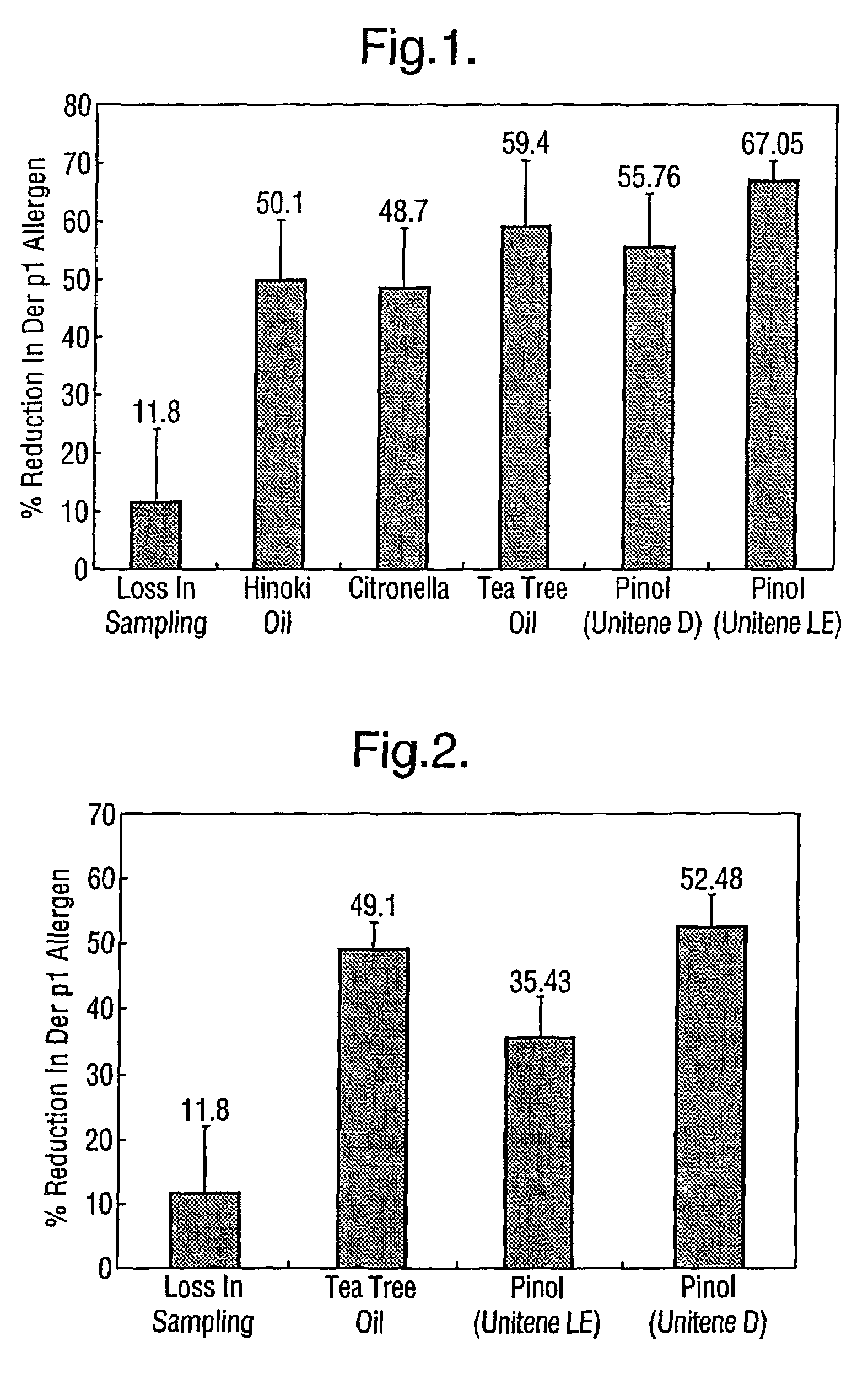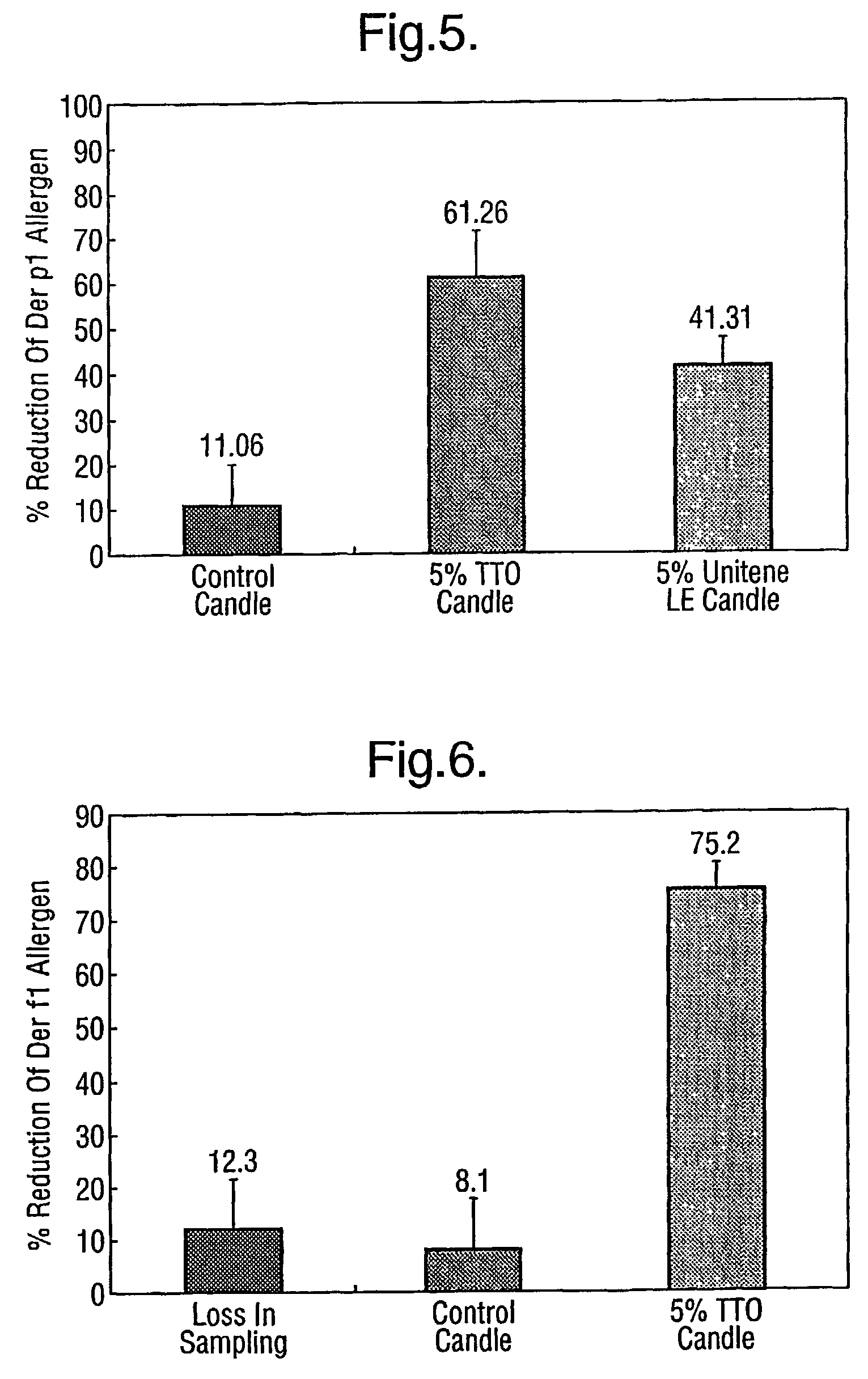Method of deactivating dust mite allergens
a technology of dust mites and allergens, applied in the field of deactivation of dust mite allergens, can solve the problem of low collision rate between allergen denaturants and airborne allergens
- Summary
- Abstract
- Description
- Claims
- Application Information
AI Technical Summary
Problems solved by technology
Method used
Image
Examples
example 1
[0043]House dust was passed through a number of sieves and the fraction smaller than 53 μm was collected. 0.1 g of dust was placed in a small sieve to distribute it evenly over the test surface, an aluminum tray 0.6 m×1 m. The dust was applied to the tray by moving the sieve continuously over the surface. As a pre-treatment control, one half of the dust was then removed by suction onto an inline filter and the weight was recorded. The tray was then placed in a plastic lined booth measuring 0.8 m×0.8 m×1.5 m. An oil burner containing 800 μl of the test sample floated on 6 ml of distilled water was placed in the booth, and the booth was sealed. The oil burner candle was lit and allowed to burn until all the liquid had been vaporized (approx. 1 hour). The candle was then smothered and the dust was left exposed in the booth. After 24 hours, the tray was removed, the dust was collected from it, and its weight was recorded. The booth was washed with strong detergent between tests of the s...
example 2
[0052]House dust was passed through a number of sieves and the fraction smaller than 53 μm was collected. 0.1 g of dust was placed in a small sieve to distribute it evenly over the test surface, an aluminum tray 0.6 m×1 m. The dust was applied to the tray by moving the sieve continuously over the surface. As the pre-treatment test control, one half of the dust was then removed by suction onto an in-line filter and the weight was recorded. The tray was then placed in a plastic lined booth 0.8 m×0.8 m×1.5 m.
[0053]For control tests, dust was distributed on the tray, the pre-treatment control was collected, and the dust was left in the booth for 24 hours. The tray was then removed and the dust was collected from the tray and weighed. In subsequent tests, 800 μl of volatile oil was added to 150 ml of distilled water in a nebulizer. The tests were then completed as in the control tests. The booth was washed with strong detergent between tests.
[0054]The samples evaluated were:[0055]Tea Tre...
example 3
[0060]Dust was collected from vacuum cleaner bags and passed through a series of sieves down to 53 microns. Clean petri dishes were labeled with the chemical to be tested and lined with filter paper. 0.3 g of dust was added to each dish and spread evenly over the filter paper. 0.1 g of dust was then removed from the filter paper for a control sample. The remaining dust was then redistributed evenly over the filter paper. 2.4 g±0.2 g of test chemical was sprayed onto the dust sample. The dust sample was left open to the air until the filter paper was dry. The dust was collected into eppendorfs and the weight of dust recovered was measured. 1 ml of 1% Bovine Serum Albumin-Phosphate Buffered Saline-Tween (BSA-PBS-T) was added to the control samples. 1 ml of 5% BSA-PBS-T was added to the test samples. The samples were left overnight in the refrigerator and then centrifuged for 5 minutes at 13,000 rpm. The supernatant was pipetted into an eppendorf for assay by Der-p1 ELISA.
[0061]The tes...
PUM
 Login to View More
Login to View More Abstract
Description
Claims
Application Information
 Login to View More
Login to View More - R&D
- Intellectual Property
- Life Sciences
- Materials
- Tech Scout
- Unparalleled Data Quality
- Higher Quality Content
- 60% Fewer Hallucinations
Browse by: Latest US Patents, China's latest patents, Technical Efficacy Thesaurus, Application Domain, Technology Topic, Popular Technical Reports.
© 2025 PatSnap. All rights reserved.Legal|Privacy policy|Modern Slavery Act Transparency Statement|Sitemap|About US| Contact US: help@patsnap.com



